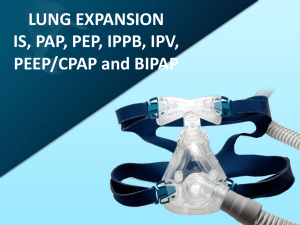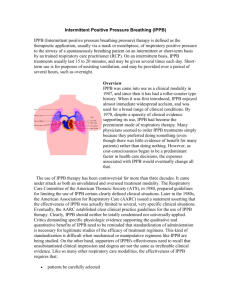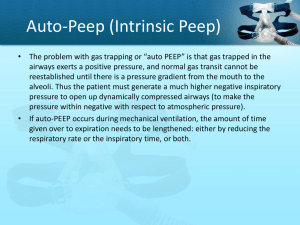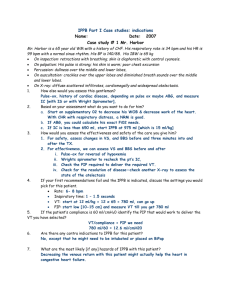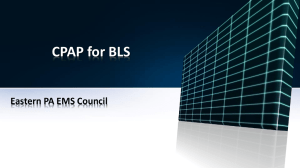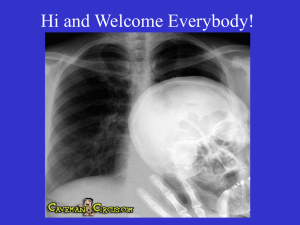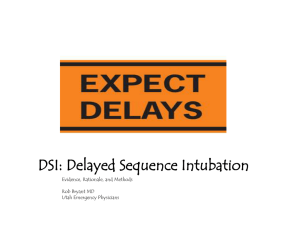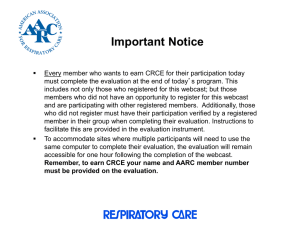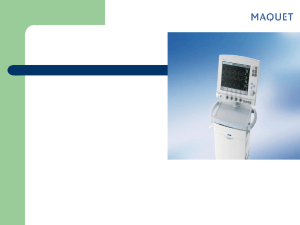File - Respiratory Therapy Files
advertisement
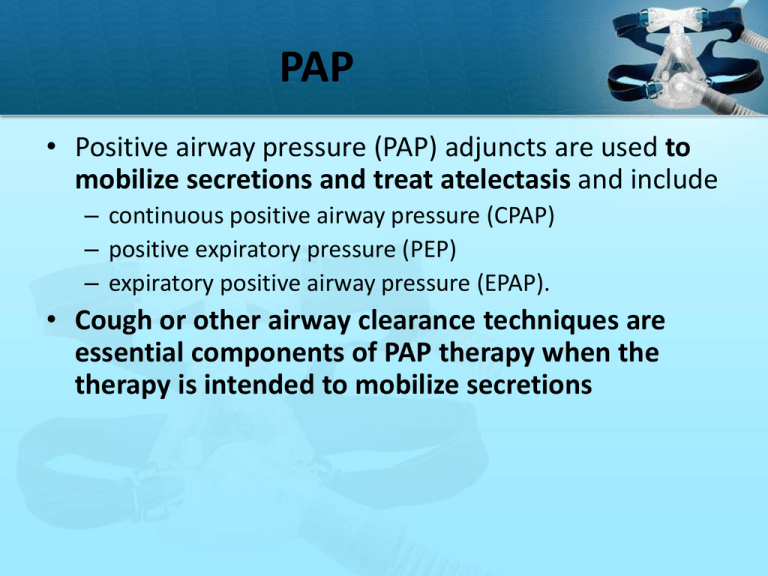
PAP • Positive airway pressure (PAP) adjuncts are used to mobilize secretions and treat atelectasis and include – continuous positive airway pressure (CPAP) – positive expiratory pressure (PEP) – expiratory positive airway pressure (EPAP). • Cough or other airway clearance techniques are essential components of PAP therapy when the therapy is intended to mobilize secretions PAP: CPAP • The patient breathes from a pressurized circuit against a threshold resistor (water-column, weighted, or spring loaded) that maintains consistent preset airway pressures from 5 to 20 cm H2O during both inspiration and expiration – (By strict definition, CPAP is any level of aboveatmospheric pressure.) • CPAP requires a gas flow to the airway during inspiration that is sufficient to maintain the desired positive airway pressure. PAP: CPAP • Types of threshold resistors: all of these valves operate on the principle that the level of PAP generated within the circuit depends on the amount of resistance that must be overcome to allow gas to exit the exhalation valve. • They provide predictable, quantifiable, and constant force during expiration that is independent of the flow achieved by the patient during exhalation PAP: CPAP • Underwater seal resistor: – expiratory port of the circuit is submerged under a column of water, the level of CPAP is determined by the height of the column • Weighted-ball resistor: – consists of a steel ball placed over a calibrated orifice, which is attached directly above the expiratory port of the circuit PAP: CPAP • Spring-loaded: – rely on a spring to hold a disc or diaphragm down over the expiratory port of the circuit. • Magnetic valve resistors – contain a bar magnet that attracts a ferromagnetic disc seated on the expiratory port of the circuit the amount of pressure required to separate the disc from the magnets is determined be the distance between them. PAP: PEP • The patient exhales against a fixed-orifice resistor, generating pressures during expiration that usually range from 10 to 20 cm H2O • PEP does not require a pressurized external gas source. • The amount of PEP varies with the size of the orifice and the level of expiratory flow produced by the patient. The smaller the orifice the greater the pressure. PAP: PEP • Thus the patient must be encourage to generated a flow high enough to maintain expiratory pressure at 10-20 mm H2O • Ideal I:E of 1:3 or 1:4 • The patient should perform 10-20 breaths through the device and then perform 2-3 huff breath coughs • This should be repeated 5-10 times during a 15-20 minute session PAP: EPAP • The patient exhales against a threshold resistor, generating preset pressures of 10 to 20 cm H2O (similar to CPAP expiration) • EPAP does not require a pressurized external gas source. • EPAP utilizing threshold resistors does not produce the same mechanical or physiologic effects that PEP does when a fixed orifice resistor is used. • Further study is necessary to determine how these differences affect clinical outcome. IPPB, IPV, PEEP/CPAP and BIPAP October 1 & 8 INTERMITTENT POSITIVE PRESSURE BREATHING IPPB • Intermittent Positive Pressure Breathing (IPPB) is a short-term breathing treatment where increased breathing pressures are delivered via ventilator to help treat atelectasis, clear secretions or deliver aerosolized medications • IPPB can include pressure- and time-limited, as well as pressure, time, and flow-cycled ventilation. • IPPB may be delivered to artificial airways and non-intubated patients. IPPB • INDICATIONS: The need to improve lung expansion The presence of clinically significant pulmonary atelectasis when other forms of therapy have been unsuccessful (incentive spirometry, chest physiotherapy, deep breathing exercises, positive airway pressure) or the patient cannot cooperate IPPB • Inability to clear secretions adequately because of pathology that severely limits the ability to ventilate or cough effectively and failure to respond to other modes of treatment • The need for short-term ventilatory support for patients who are hypoventilating as an alternative to tracheal intubation and continuous mechanical ventilation IPPB • The need to deliver aerosol medication. • IPPB may be used to deliver aerosol medications to patients with fatigue as a result of ventilatory muscle weakness (eg, failure to wean from mechanical ventilation, neuromuscular disease, kyphoscoliosis, spinal injury) or chronic conditions in which intermittent ventilatory support is indicated (eg, ventilatory support for home care patients and the more recent use of nasal IPPV for respiratory insuff iciency) IPPB • Assessment of need: – Presence of significant atelectasis – Reduced pulmonary function, reduced VC, VT – Neuromuscular disorders – Prevention of atelectasis Assessment of Outcome: – Minimum VT of at least 1/3 of predicted IC – Increase in FEV1 – More effective cough, CXR improved, BS improved IPPB • CONTRAINDICATIONS: There are several clinical situations in which IPPB should not be used. With the exception of untreated tension pneumothorax, most of these contraindications are relative: – Increased ICP >15 mmHg – Hemodynamically unstable – Recent Facial, oral or skull surgery – Tracheoesphogeal fistula IPPB – Recent Espohageal surgery – Active hemoptysis – Nausea – Air swallowing – Active TB – Blebs – Singulation (hiccups) IPPB • Hazards/complications – Increased RAW and WOB – Barotrauma/pneumothorax – Nosocomial infection – Hypocarbia – Hemoptysis – Hyperoxia when O2 used as gas source – Gastric distension – Impaction of secretions IPPB – Impendance of venous return – Air trapping Limitations of Device – Effects are short lived, lasting an hour – Delivery of medication is ineffective due to low delivering flow through nebulizer – Patient dependent – IPPB equipment is labor intensive – Limited portability IPPB • IPPB is pneumatically powered • Patient triggered and pressure cycled • You set: Pressure limit, flow, sensitivity IPPB • Given through a mouth piece or mask • Varying types, BIRD Mark series, PB IPPB Setup Flow rate adjustment. Sensitivity adjustment Pressure adjustment Pressure manometer. Negative should not be more than -2, if it is adjust your sensitivity Air mix, either 100% if pushed in or 80% pulled out IPPB • How the machine works: • In IPPB, we set a driving pressure [PIP] on the machine, and when the patient triggers the machine by decreasing the pressure in the line, gas starts to move down the tube into the mouth and airways. • When the preset PIP is reached, the gas flow shuts down immediately. The inspiratory phase has cycled off. IPPB: Pressure • Pressure set on the IPPB will determine the pressure limit • Pressure is directly related to volume, increasing the pressure limit will increase the volume in the lung • Measure VT with • Venti-comp bag IPPB Pressure • Pressure is typically started low, around 10-15 cmH2O and increased to achieve desired VT. Remember, IPPB is hyperinflation therapy, the goal is to exceed normal tidal volume ranges. • Once the machine is triggered on by the patient and pressure is reached (seen on manometer) the machine cycles off • Too much pressure can cause barotrauma IPPB Flow • The flow setting on the IPPB dictates how fast the pressure limit is reached • High flow = low inspiratory time • Low flow = high inspiratory time • Start low around 5-10 L and increase depending on the desired inspiratory time • Normal times should be around 1-1.5 seconds for inspiration IPPB Flow • To decrease the inspiratory time we need to increase the flow rate • To increase the inspiratory time, we need to decrease the flow rate • If we increase the PIP to increase the VT, sometimes the inspiratory time is too long and we have to increase the flow rate. • Remember that really fast flow rates will only cause increased RAW, so keep the inspiratory time between 1-1.5 seconds for adults. • Remember that the air mix mode involves air entrainment so the flow rate will be changed by changing the Fi02 IPPB Sensitivity • The sensitivity on the IPPB machine is manipulated by the dial on the left hand side of the machine. Increasing the “Inspiratory Effort” dial will make the machine less sensitive to the patients inspiratory trigger. This increases the magnetic pull inside the sub atmospheric side of the ,IPPB bird machine making it more difficult for the patient to trigger the machine on, increasing WOB IPPB Sensitivity • Decreasing the “patient effort” dial will make the machine more sensitive to the patients inspiration. • This may cause “auto-triggering” if it is set too low. • Decreasing this dial creates less magnetic pull on the diaphragm in the middle of the machine IPPB FIO2 • If you do not wish to deliver high FIO2 to the patient during the IPPB procedure, attach the machine to a air outlet, otherwise the only two FIO2 available are 100% or 80% with air dilution • NOTE: on the IPPB machine there is a APNEAexpiratory time setting, do not turn this on unless you want a back up rate. Breathing while on IPPB • Remember, this is not ventilation. IPPB is a sustained maximal inspiration just like IS, so we do not need to breathe much faster than 6-8 bpm. The patient may breathe faster, but he can do so off the IPPB. • Rapid RR on the IPPB will increase chances of impeding venous return to the heart, reducing the amount of blood in the heart which would cause the patient to become tachycardiac in order the keep the same cardiac output. Breathing while on IPPB • If the patient becomes light headed, dizzy or feels tingling in their fingers during the procedure- STOP and allow patient to rest, this is caused by the quick elimination of CO2 • Rapid RR will encourage air trapping, particularly in persons with increased RAW and wheezing—we need plenty of time to exhalation Breathing while on IPPB • We need to allow for a 3-5 second inspiratory hold. • Remember this is a SMI, that includes a slow deep breath and inspiratory hold to get the gas and the medications deep into the periphery of the lung. The patient can take his mouth off the IPPB mouthpiece to do this breath hold—unless we need to measure the VT. IPPB Troubleshooting • If you checked your PIP by watching the monometer while you occlude the patient connector, you will find most problems before attaching the machine to the patient. The pressure should go right to the PIP and stop immediately. The machine should not start just because you jiggle the tube. • Is the machine set for appropriate Fi02? • Is the sensitivity set for -2? • Check the PIP by monometer—not just the number on the dial • Is the circuit on nice and tight-do a tactile exam, not just looking at it. • If the SVN is set separately, is it set correctly ? IPPB Troubleshooting • • • • Breath will not come on 1. attach the high pressure line to the gas 2. turn on the flow rate 3. check the sensitivity; set the machine to trigger by itself [auto-cycling] then turn back a bit. • 4. does the patient have a tight seal? Mouth closed? Lips tight, nose closed or nose clips? IPPB Troubleshooting • Breath starts too easily • 1. sensitivity is set too low. Auto-cycling is when the machine triggers itself just by jiggling the tube. • Breath will not end • 1. check the flow rate; too slow • 2. does the patient have a tight seal? Mouth closed? Lips tight, nose closed or nose clips? LEAKS • 3. check the mushroom valve, the nebulizer line, the nebulizer cup and the mainline for leaks. IPPB Troubleshooting • Inhalation goes on past 1-1.5 seconds • 1. flow rate is too slow for this patient • 2. check for small leaks that prevent the pressure from rising. Look at the pressure on the monometer, there should be a steady rise in pressure • 3. if the pressure is wavering just lower than the PIP, the patient is ‘leading the machine.’ Ask him to relax & let the machine do the work. • He is inhaling too fast—also increase the flow rate per his comfort level • 4. if you moved from air mix to 100% Fi02, you lost the entrainment so the flow rate needs to be increased again INTRAPULMONARY PERCUSSONATOR IPV • Intrapulmonary percussive ventilation (IPV) is a therapeutic modality designed to clear and maintain pulmonary airways. IPV is used to mobilize and clear retained secretions, assist in the resolution of atelectasis, and to deliver aerosolized medications. Oscillatory pulsations are delivery by the "Percussionator" which generates high frequency bursts of gas at rates of 100 to 300 cycles per minute (2 – 5 Hz). The mini bursts of air are delivered to the patient's airways at pressures of 10 – 20 cm H20, however this range may be adjusted to match the compliance and resistance of the lung and chest wall. IPV • IPV was depicted as delivering “high flow mini-bursts of air along with bronchodilator to the lungs at a rate of 300–400 times per minute.” • operates at 1.7 Hz to 5 Hz and generates esophageal pressure and airflow oscillations • Treatments last about 15–20 min • This device is designed to be used in conjunction with conventional mechanical ventilation, if desired, or as a stand-alone treatment device. It can be used with a mouthpiece or mask, and it can also deliver aerosolized medication. IPV • http://www.youtube.com/watch?v=ARJLALFf2 e0 • Pneumatically powered • Nebulizer cup, uses a phasitron to create oscillations, bacterial filter, circuit- colored coded- connect lines to device • Set Drive pressure (based on patients compliance) • Set percussion level PEEP • Positive end-expiratory pressure (PEEP) is the pressure in the lungs (alveolar pressure) above atmospheric pressure that exists at the end of expiration. The two types of PEEP are extrinsic PEEP (PEEP applied by a ventilator) and intrinsic PEEP (PEEP caused by a non-complete exhalation). PEEP • There are three purposes to using PEEP: • 1) To prevent derecruitment, by returning the functional residual volume to the physiologic range. 2) To protect the lungs against injury during phasic opening an closing of atelectatic units. • 3) To assist cardiac performance, during heart failure, by increasing mean intrathoracic pressure. PEEP • Applied (Extrinsic) PEEP — Applied PEEP can be given through invasive or non-invasive ventilation. • Works by increasing alveolar pressure to increase FRC, Mean Airway pressure and ultimatley improve compliance and improve oxygenation • PEEP is given in the range of about 3-5 and used to mitigate end-expiratory alveolar collapse. A higher level of applied PEEP (>5 cmH2O) is sometimes used to improve hypoxemia or reduce ventilatorassociated lung injury in patients with acute lung injury, acute respiratory distress syndrome, or other types of hypoxemic respiratory failure A: Collapsed alveoli on exhalation without PEEP B: Inflated alveoli on exhalation with PEEP C: Inflated alveoli on inspiration with PEEP Auto-Peep (Intrinsic Peep) • Auto-PEEP is gas trapped in alveoli at end expiration, due to inadequate time for expiration, bronchoconstriction or mucus plugging. It increases the work of breathing. • Auto-PEEP is caused by gas trapped in alveoli at end expiration. This gas is not in equilibrium with the atmosphere and it exerts a positive pressure, increasing the work of breathing, Auto-Peep (Intrinsic Peep) • The problem with gas trapping or “auto PEEP” is that gas trapped in the airways exerts a positive pressure, and normal gas transit cannot be reestablished until there is a pressure gradient from the mouth to the alveoli. Thus the patient must generate a much higher negative inspiratory pressure to open up dynamically compressed airways (to make the pressure within negative with respect to atmospheric pressure). • If auto-PEEP occurs during mechanical ventilation, the amount of time given over to expiration needs to be lengthened: either by reducing the respiratory rate or the inspiratory time, or both. CPAP • CPAP is the application of continuous positive airway pressure, patient is breathing spontaneously. Pressure is at one level • CPAP is a mode, and also a setting • Synonymous with PEEP, and EPAP • Given for a variety reasons, including: – Refractory hypoxemia – OSA – RDS… CPAP • CPAP can be applied non-invasively, through a BiPAP machine, CPAP machine, or SiPAP machine or it can be given invasively through a continuous mechanical ventilator • CPAP is otherwise known as PEEP, can be given to all age groups NASAL CPAP Home vs. Hospital NPPV • Application of positive pressure without airway intubation for the purpose of augmenting alveolar ventilation • Patient’s using NPPV are typically awake/alert and breathing spontaneously Goals of NPPV • Acute Care – Avoid intubation – Improve mortality – Relieve symptoms – Enhance gas exchange – Improve ventilator-patient synchrony – Maximize patient comfort – Decrease incidence of ventilator-acquired pneumonia (VAP) Goals of NPPV • Chronic Care – Relieve or improve symptoms – Enhance quality of life – Avoid hospitalization – Increase survival – Improve mobility Indications for NPPV • Disease states – Asthma • Used in treatment of acute attack to avoid intubation, HHN can be given inline • Many tend to be claustrophobic and don’t tolerate procedure – Acute exacerbation of COPD • Studies indicate that NPPV should be first-line intervention in treatment • Only beneficial in acute exacerbation/HHN treatment can be given inline – Acute cardiogenic pulmonary edema • Administered as first-line treatment, NO HHN treatment indicated • Not recommended for patients with myocardial infarction, arrhythmias, hemodynamic instability, or depressed mental status Indications for NPPV • Other indications – Neurologic/neuromuscular disease • Should always be considered as a first-Line treatment • Works well when applied to patients with progressively deteriorating disease • Will use NPPV until the patient requires invasive PPV – Weaning from ventilatory support • May be indicated for patients who have failed at weaning attempts but for whom clinical signs indicate they should be weaned • May be used with patients failing extubation Indications for NPPV • Other indications – Immunosuppressed patients/patients awaiting lung transplant • Avoidance of intubation – leads to nosocomial pneumonia • Should always be considered as a first-Line treatment – Acute lung injury • Should be applied with caution to ALI patients • If no response within a few hours, patient should be intubated – DNR patients (controversial) • Used to prolong life until family members arrive • Used to transport patient home to die • Provide comfort during last hours of life Indications for NPPV • Chronic care settings – Relief of nocturnal hypoventilation in COPD patients – Nocturnal use for restrictive thoracic diseases • Rest respiratory muscles • Lower PaCO2 to establish new baseline value • Improve lung compliance, lung volume, and reduce dead space – Treat nocturnal hypoventilation • Obesity hypoventilation • Obstructive sleep apnea • Central sleep apnea NPPV for OSA Patients with OSA often use CPAP via face, nasal or nasal pillow masks. Often poorly tolerated. NPPV for OSA • Obstructive sleep apnea (OSA) is the most common type of sleep apnea and is caused by obstruction of the upper airway. It is characterized by repetitive pauses in breathing during sleep, despite the effort to breathe, and is usually associated with a reduction in blood oxygen saturation. These pauses in breathing, called apneas (literally, "without breath"), typically last 20 to 40 seconds. • The individual with OSA is rarely aware of having difficulty breathing, even upon awakening. It is recognized as a problem by others witnessing the individual during episodes or is suspected because of its effects on the body (sequelae). OSA is commonly accompanied with snoring. • Leads to cardiac problems, brain problems, HTN… Selection Criteria for NPPV in Acute Respiratory Failure • Use of accessory muscles • Paradoxical breathing • Respiratory rate > 25 breaths/min • Dyspnea (moderate to severe or increased over normal levels) • PaCO2 > 45 mmHg with pH < 7.35 • PaO2/FIO2 ratio < 200 BiPAP • Two levels of non-invasive positive pressure. • BiPAP is a trademarked name from Respironics • IPAP: Inspiratory positive airway pressure, a pressure limit, increases in IPAP = increases in VT • EPAP: Expiratory positive airway pressure, PEEP, applied on expiration to increase FRC • Set IPAP and EPAP at least 5 apart to create a pressure gradient, this difference is called pressure support Bipap • The BiPAP machine has two basic modes: – S/T (Spontaneous timed): You set a IPAP, EPAP, Rate, inspiratory time and FIO2. The rate only applies when the patient falls below the minimum back up rate, once he or she does the machine is termed time cycled. Otherwise all breaths are spontaneously triggered. Set alarms – CPAP: Set a PEEP/EPAP level, along with FIO2, no back up rate set. Watch for apnea, set apnea alarm Bipap • Typical settings for Bipap: – IPAP 10-15 cmH2O (increase or decrease based on PaCO2) – EPAP 5-10 cmH2O (increase/decrease based on PaO2) – Rate 6-10 (rate set low, patient should be breathing spontaneously) – FIO2 21-100% (based on SpO2, PaO2…) – I-time 1.0 second (usually a non issue since rate is low) – Rise time 0.4 seconds (only applies to timed breath) – Once BiPAP is applied, assess comfort, monitor Vte, RR, HR, SpO2, BP, cardiac rhythm, Ve… – Get a ABG about 1-2 hours after initiation – Leaks are the number one cause of alarm BiPAP • Bipap is typically setup quickly with the mask being the most cumbersome aspect of setup • BiPAP should be used as a temporary means of augmenting/ assisting in a patients respiratory distress. Prolonged use typically suggests the patient may need intubation • Commonly used in the ER for CHF/pulmonary edema, but also for a wide range of other reasons Bipap • The most important factors in applying BiPAP are: – Is the patient a proper candidate for BiPAP or do they need to be intubated – Note contraindications for device – Is the mask appropriate for the patient (correct size and fit) – Proper settings Exclusion Criteria for NPPV in Acute Respiratory Failure • Apnea (NPPV/BIPAP only for spontaneously breathing pts) • Hemodynamic instability • Uncooperative patient behavior (may need sedation) • Facial burns or other trauma • Copious secretions (Devices can dry secretions) • High risk of aspiration • Anatomic abnormalities that interfere with gas delivery Exclusion Criteria in the Chronic Care Setting • Unsupportive family • Lack of financial resources • Uncooperative patient behavior • Copious secretions • High risk of aspiration • Anatomic abnormalities that interfere with gas delivery • Ventilatory support required most waking hours Administration of NPPV – Patient Interfaces • Nasal mask – Triangular in shape; made to fit around the nose – Most common interface – Fitting of mask dependent upon manufacturer’s specifications – Leakage through the mouth can be a significant problem, may need chin strap Administration of NPPV – Patient Interfaces • Full face masks – Surrounds nose and mouth, resting below lower lip – Seal easier to maintain because both mouth and nose covered – Associated with increased dead space, risk of aspiration, and claustrophobia – Asphyxiation can occur in Ventilator failure so alarms must be functional Administration of NPPV – Patient Interfaces • Nasal pillows – Consists of two small cushions that fit under the nose – Has limited pressure range of use – 3 to 20 cmH2O – More comfortable than facial masks, but gas leakage may be a problem. Gas leaks out of the mouth, may need chin strap Administration of NPPV – Patient Interfaces • Total face mask – Surrounds entire face – One size available for quick application in emergencies – Does have increased dead space, but decreases claustrophobic feeling because it does not obscure vision – Alternate masks to reduce pressure sores on face Administration of NPPV – Humidification • Heated humidification has been noted to decrease nasal resistance and congestion • Cold passover humidification does not significantly relieve nasal resistance • Heated humidification increases patient compliance with the procedure Administration of NPPV – Initiation • Successful application requires that the patient be part of the process. They must understand what is to be done and be fully cooperative in the process. Administration of NPPV – Initiation • Place patient at an angle ≥ 30⁰ • Determine correct size and type of patient interface (very important, if patient is uncomfortable they are non-compliant) • Attach patient interface to circuit • Select initial settings – PEEP: 0 – 4 cmH2O – Ventilating pressure: < 5 cmH2O (typically 10-15) – Expected VT: 200 – 500 mL • Once you input your settings and alarms connect to patient Administration of NPPV – Initiation • Select initial settings – FIO2: maintain SpO2 > 90% – Rate: determined by patient, again set low Administration of NPPV – Initiation • Hold the mask on the patient’s face or have the patient hold the mask on the face • When patient is comfortable with mask, use straps to hold in place • Do not overly tighten or let too loose Administration of NPPV – Initiation • Adjust FIO2 as necessary to maintain SpO2 > 90% • Adjust mask as necessary to correct any air leaks, do not put tape on mask to prevent leaks. Ensure exhalation ports are open Administration of NPPV – Initiation • As patient becomes comfortable, adjust inspiratory positive airway pressure (IPAP) until VT is between 4 and 6 mLs/kg or until signs of respiratory distress improve Administration of NPPV – Initiation • Increase expiratory positive airway pressure (EPAP or PEEP) to reduce dyssynchrony from air trapping or to improve oxygenation Administration of NPPV – Assessment • Assessment after initial two hours indicating successful administration – Decrease in PaCO2 – Increase in pH – Increase in PaO2 – Decreased WOB Administration of NPPV – Assessment • Assessment after initial two hours indicating successful administration – Decrease in respiratory rate – Normalization of heart rate and respiratory rate – Normalization of ventilatory pattern Administration of NPPV – Assessment • Failure to observe improvement requires reassessment to determine need for intubation • If patient shows some signs of improvement, continue to evaluate to determine success or failure of procedure and initiate appropriate action • NPPV should be used as a short term application, or used on a nightly or intermittent basis Administration of NPPV – Assessment • Be cautious to avoid prolongation of the procedure; allowing patient to continue too long without significant improvement can create difficulties for intubation or stabilization later Side Effects Side Effect Mask related Discomfort Facial skin erythema Claustrophobia Nasal bridge ulceration Acneiform rash Air pressure or flow related Nasal congestion Sinus or ear pain Nasal or oral dryness Eye irritation Gastric insufflations Possible Remedy Check fit, adjust strap, change to new type of mask Loosen straps, apply artificial skin Use a smaller mask, change type of mask, give sedative Loosen straps, apply artificial skin, change mask type Administer topical steroids or antibiotics Administer nasal steroids, decongestant, or antihistamines Reduce pressure if pain is intolerable Apply nasal saline solution, add humidifier, decrease leak Check mask fit, readjust straps Reassure the patient, give simethicone, reduce pressure to relieve excessive pain Side Effects Side Effect Air leaks Major complications Aspiration pneumonia Hypotension Pneumothorax Possible Remedy Encourage mouth closure, try chin straps, try oronasal mask if using nasal mask, reduce pressure slightly Select patients carefully Reduce IPAP Stop ventilation if possible, reduce airway pressure; insert chest tube if indicated Side Effects Slow skin breakdown by applying Mepilex or DuoDerm tape to patient’s face, typically the bridge of the nose and forehead and sides of face Contraindications • Absolute – Untreated pneumothorax – Patient without a paten airway – Apnea – Inability to fit interface due to deformity Contraindications • Relative – Unstable hemodynamic state – Facial trauma HW assignment • Part 1. Assess the use and application of IPPB and IPV as a means for hyperinflation and bronchial hygiene therapy. Is there evidence supporting there effective use? (2 pages) • Part 2. Explain why or why not the use of BiPAP in DNR patients is justified. I want your opinion on the ethical implications as well as the functionality of the Bipap as a ventilation assistant(2 pages) • Use peer reviewed literature to write a minimum of two pages on each topic. You may email me your articles or attach them with your paper. Use correct referencing • DUE OCTOBER 8th • Michaines@hotmail.com
